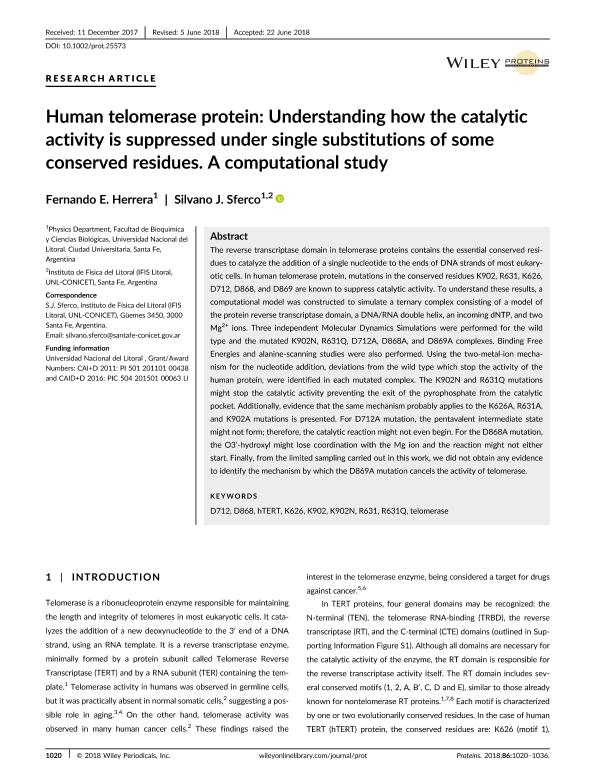Mostrar el registro sencillo del ítem
dc.contributor.author
Herrera, Fernando Enrique

dc.contributor.author
Sferco, Silvano Juan

dc.date.available
2022-11-04T11:26:17Z
dc.date.issued
2018-11
dc.identifier.citation
Herrera, Fernando Enrique; Sferco, Silvano Juan; Human telomerase protein: understanding how the catalytic activity is suppressed under single substitutions of some conserved residues. A computational study; Wiley-liss, div John Wiley & Sons Inc.; Proteins: Structure, Function And Genetics; 86; 10; 11-2018; 1020-1036
dc.identifier.issn
0887-3585
dc.identifier.uri
http://hdl.handle.net/11336/176362
dc.description.abstract
The reverse transcriptase domain in telomerase proteins contains the essential conserved residues to catalyze the addition of a single nucleotide to the ends of DNA strands of most eukaryotic cells. In human telomerase protein, mutations in the conserved residues K902, R631, K626, D712, D868, and D869 are known to suppress catalytic activity. To understand these results, a computational model was constructed to simulate a ternary complex consisting of a model of the protein reverse transcriptase domain, a DNA/RNA double helix, an incoming dNTP, and two Mg2+ ions. Three independent Molecular Dynamics Simulations were performed for the wild type and the mutated K902N, R631Q, D712A, D868A, and D869A complexes. Binding Free Energies and alanine-scanning studies were also performed. Using the two-metal-ion mechanism for the nucleotide addition, deviations from the wild type which stop the activity of the human protein, were identified in each mutated complex. The K902N and R631Q mutations might stop the catalytic activity preventing the exit of the pyrophosphate from the catalytic pocket. Additionally, evidence that the same mechanism probably applies to the K626A, R631A, and K902A mutations is presented. For D712A mutation, the pentavalent intermediate state might not form; therefore, the catalytic reaction might not even begin. For the D868A mutation, the O3′-hydroxyl might lose coordination with the Mg ion and the reaction might not either start. Finally, from the limited sampling carried out in this work, we did not obtain any evidence to identify the mechanism by which the D869A mutation cancels the activity of telomerase.
dc.format
application/pdf
dc.language.iso
eng
dc.publisher
Wiley-liss, div John Wiley & Sons Inc.

dc.rights
info:eu-repo/semantics/openAccess
dc.rights.uri
https://creativecommons.org/licenses/by-nc-sa/2.5/ar/
dc.subject
D712
dc.subject
D868
dc.subject
HTERT
dc.subject
K626
dc.subject
K902
dc.subject
K902N
dc.subject
R631
dc.subject
R631Q
dc.subject
TELOMERASE
dc.subject.classification
Biofísica

dc.subject.classification
Ciencias Biológicas

dc.subject.classification
CIENCIAS NATURALES Y EXACTAS

dc.title
Human telomerase protein: understanding how the catalytic activity is suppressed under single substitutions of some conserved residues. A computational study
dc.type
info:eu-repo/semantics/article
dc.type
info:ar-repo/semantics/artículo
dc.type
info:eu-repo/semantics/publishedVersion
dc.date.updated
2022-11-03T15:46:24Z
dc.journal.volume
86
dc.journal.number
10
dc.journal.pagination
1020-1036
dc.journal.pais
Estados Unidos

dc.journal.ciudad
New York
dc.description.fil
Fil: Herrera, Fernando Enrique. Universidad Nacional del Litoral. Facultad de Bioquímica y Ciencias Biológicas. Departamento de Física; Argentina. Consejo Nacional de Investigaciones Científicas y Técnicas. Centro Científico Tecnológico Conicet - Santa Fe; Argentina
dc.description.fil
Fil: Sferco, Silvano Juan. Consejo Nacional de Investigaciones Científicas y Técnicas. Centro Científico Tecnológico Conicet - Bahía Blanca. Instituto de Física del Sur. Universidad Nacional del Sur. Departamento de Física. Instituto de Física del Sur; Argentina. Universidad Nacional del Litoral. Facultad de Bioquímica y Ciencias Biológicas. Departamento de Física; Argentina
dc.journal.title
Proteins: Structure, Function And Genetics

dc.relation.alternativeid
info:eu-repo/semantics/altIdentifier/url/http://doi.wiley.com/10.1002/prot.25573
dc.relation.alternativeid
info:eu-repo/semantics/altIdentifier/doi/http://dx.doi.org/10.1002/prot.25573
Archivos asociados
